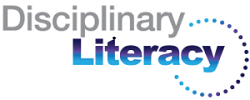What is Disciplinary Literacy?

The value of embedding literacy instruction in content teaching has been known for decades. Back in 1979 while studying for my Masters degree, one of my courses was titled Reading in the Content Areas. Since then, I have come across literally hundreds of books and courses with the same title. There has long been a consensus based on decades of research that content teachers can play an important role in teaching students literacy skills (Snow, 2002; Meltzer et al, 2003; Biancarosa & Snow, 2004). This is a major tenet of the Common Core State Standards, as evidenced in the title of the literacy standards: Standards for English Language Arts and Literacy in History/Social Studies, Science, and Technical Subjects and highlighted in the introduction to the standards:
“Literacy standards for grade 6 and above are predicated on teachers of ELA, history/social studies, science, and technical subjects using their content area expertise to help students meet the particular challenges of literacy in their respective fields.” (Common Core, 2010, p. 3)
Traditionally, the goal of content literacy instruction has been to increase students’ ability to write, listen and speak as they read and learn content from different subjects, also described as content disciplines. My Key Comprehension Routine, Key Vocabulary Routine, and Keys to Content Writing professional development programs train teachers of all subjects how to provide content literacy instruction. I believe that content teachers are in the best position to do this because they know the unique demands of reading and writing in mathematics, science, history, or other specific disciplines.
In the last several years the term disciplinary literacy is popping up in educational publications and research articles. Most teachers I know conclude that this must just be another name for content literacy. But for those who are considered disciplinary literacy experts, there is a fundamental difference between content and disciplinary literacy.
What is disciplinary literacy?
Timothy and Cynthia Shanahan published a 2012 article in Top Language Disorders that is often cited in discussions about disciplinary literacy titled “What is disciplinary literacy and why does it matter?”
They describe the difference between content and disciplinary literacy this way:
“Content area literacy focuses on study skills that can be used to help students learn from subject matter specific texts. Disciplinary literacy, in contrast, is an emphasis on the knowledge and abilities possessed by those who create, communicate, and use knowledge within the disciplines. The difference is that content literacy emphasizes techniques that a novice might use to make sense of a disciplinary text (such as how to study a history book for an examination), whereas disciplinary literacy emphasizes the unique tools that the experts in a discipline use to engage in the work of that discipline… Content area reading prescribes study techniques and reading approaches that can help someone to comprehend or to remember text better (with little regard to type of text), whereas disciplinary literacy emphasizes the description of unique uses and implications of literacy use within the various disciplines.” (p. 8)
Emily Rainer and Elizabeth Moje wrote about disciplinary literacy in a 2012 article published in English Education titled “Building Insider Knowledge: Teaching Students to Read, Write, and Think within ELA and across the Disciplines”.
They describe disciplinary literacy this way:
“Disciplinary literacy refers to the shared ways of reading, writing, thinking, and reasoning within academic fields (Moje, 2007; Shanahan & Shanahan, 2008). Each discipline has unique ways of asking questions and solving problems. Similarly, each discipline has unique expectations for the types of claims that are made and the way those claims are supported. These differences play out in the ways that texts are written and in the demands those texts place on the readers. For these reasons, we can say that each discipline has its own discourse community, a shared way of using language and constructing knowledge.” (p. 73)
They also note:
“Disciplinary literacy practices are cultural constructions, and many of those practices are not learned simply by observation. Thus, middle school and high school teachers, who are already part of the disciplinary culture by virtue of their disciplinary preparation, need to help students into the culture by making explicit the discipline-specific literacy practices of their areas (Greenleaf, Schoenbach, Cziko, & Mueller, 2001). Such disciplinary literacy instruction does not seek to make experts of teen- age students. Rather, disciplinary literacy instruction begins to help students to read, write, and think in ways that are aligned with experts in the field.” (p. 73)
I have a mixed reaction to this relatively new focus on disciplinary literacy. On the one hand, it makes sense that students should benefit from learning what is unique about the way literacy is used in one discipline such as math versus another discipline such as history. This is especially the case for students who go on to post-secondary education or who start careers in areas that require a high degree of disciplinary-specific reading and writing skills.
On the other hand, there are huge numbers of high school students who have below grade-level reading and writing skills — they have not learned even basic content comprehension and writing skills. My concern is that high school, and especially middle school, content teachers will focus on more advanced disciplinary literacy skills at the expense of teaching more fundamental content literacy skills.
This sentiment is reflected in a 2012 article by Michael Fagella-Luby and colleagues in the same issue of Top Language Disorders as the Shanahans’ piece. It is titled “Building a House on Sand: Why Disciplinary Literacy Is Not Sufficient to Replace General Strategies for Adolescent Learners Who Struggle”
They note this about disciplinary literacy:
“There is growing interest in disciplinary literacy instruction as a primary means of improving adolescent literacy outcomes. At times, this disciplinary framework has been represented as a replacement for the more broadly known general strategy instruction. However, disciplinary literacy, a potentially powerful idea, cannot replace general strategy instruction for all adolescent learners because adolescents who struggle with reading and writing do not possess the foundational skills and strategies necessary to learn proficiently. We believe that such a statement is necessary because, at times (including Fang, 2012, and Shanahan & Shanahan, 2012), disciplinary literacy has been represented as a replacement for the more broadly known general strategy instruction. To suggest that content teachers need only focus on the strategies that will unpack the complexity of specific concepts in certain content areas is a likely recipe for teacher frustration as teachers face the challenge of today’s academically diverse students in middle and secondary school classrooms. Moreover, such a linear disciplinary focus implies that content teachers do not bear responsibility for teaching foundational general strategy instruction to all students in their classes.” (p. 70)
Don Deschler, Director of the Center for Research on Learning at the University of Kansas, summarizes this position in a two-minute video titled “What are specific considerations that teachers must make related to disciplinary literacy for students with reading difficulties?”
Here are some additional resources related to disciplinary literacy:
- “Task, Text, and Talk: Literacy for all Subjects” (McConachie et al, 2006, Educational Leadership 64(2)
- Video: “What is Disciplinary Literacy?” (Shanahan and Spires)
- “Disciplinary Literacy and the Common Core State Standards” (Zygouris-Coe, V. I., 2012, Top Language Disorders)
References
Biancarosa, G., and Snow, C.E. (2004). Reading next: A vision for action and research in middle and high school literacy: A report from Carnegie Corporation of New York. Washington, DC: Alliance for Excellent Education.
Meltzer, J., Smith, N.C., and Clark, H. (2003). Adolescent literacy resources: Linking research and practice. Providence, R.I.: Northeast and Islands Regional Educational Laboratory at Brown University.
Snow, C. (2002). (Chair). RAND reading study group: Reading for understanding: Toward an R&D program in reading comprehension. Santa Monica, CA: RAND.

 Joan Sedita is the founder of Keys to Literacy and author of the Keys to Literacy professional development programs. She is an experienced educator, nationally recognized speaker and teacher trainer. She has worked for over 35 years in the literacy education field and has presented to thousands of teachers and related professionals at schools, colleges, clinics, and professional conferences.
Joan Sedita is the founder of Keys to Literacy and author of the Keys to Literacy professional development programs. She is an experienced educator, nationally recognized speaker and teacher trainer. She has worked for over 35 years in the literacy education field and has presented to thousands of teachers and related professionals at schools, colleges, clinics, and professional conferences.
Very useful article. I will cite in my assignment for school.
Glad you found it helpful!
This post really clarified the concept of disciplinary literacy for me! I appreciate how you broke down the different approaches for subjects like science and history. It’s inspiring to see the emphasis on critical thinking and comprehension skills tailored to specific disciplines. Looking forward to applying these insights in the classroom!
What an incredible article! The insights and guidance you’ve shared are practical and clearly explained, making them so valuable. I appreciate the effort and thoughtfulness you’ve put into this content. Your blog is amazing, and I’ll be visiting frequently. Keep up the excellent work—you’re doing great!